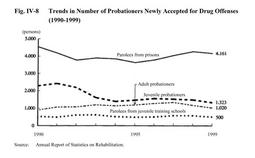| Previous Next Index Image Index Year Selection | |
|
|
3 Correction and rehabilitation of drug offenders (1)Correctional treatment
As of December31,1999,convicts for Stimulant Drug Control Law violations(here referred to as"stimulant drug convicts")accounted for27.0%(12,231persons)of all convicts, while convicts for Narcotics Control Law violations(here referred to as"narcotics convicts")accounted for0.5%(220persons). Among female convicts, they represented46.1%(1,034persons)and0.8%(17persons), respectively. Of those newly convicted in1999,stimulant drug and narcotics convicts accounted for24.5%(6,000persons)and0.3%(62persons), respectively. Convicts for drug offenses are classified into groups according to the cause and content of the offense, personality, etc. , and are then given positive education designed to raise awareness of the harmful effects of drugs, develop law-abiding attitudes, and so on. Awareness activities on the harmful effects of stimulant drugs, etc. , are also conducted for other convicts as part of the guidance provided at the start of their sentences, as well as prior to release from prison. (2)Rehabilitation Fig. IV-8 shows the number of probationers newly accepted for drug offenses over the last10years. Under probationary supervision, abusers of solvents, etc. , and drug offenders are classified according to their motives for drug abuse, channels of access, the extent of their dependency, the degree of abuse, etc. , to ensure effective treatment based on the individual characteristics of probationers. Fig. IV-8 Trends in Number of Probationers Newly Accepted for Drug Offenses(1990-1999) |
